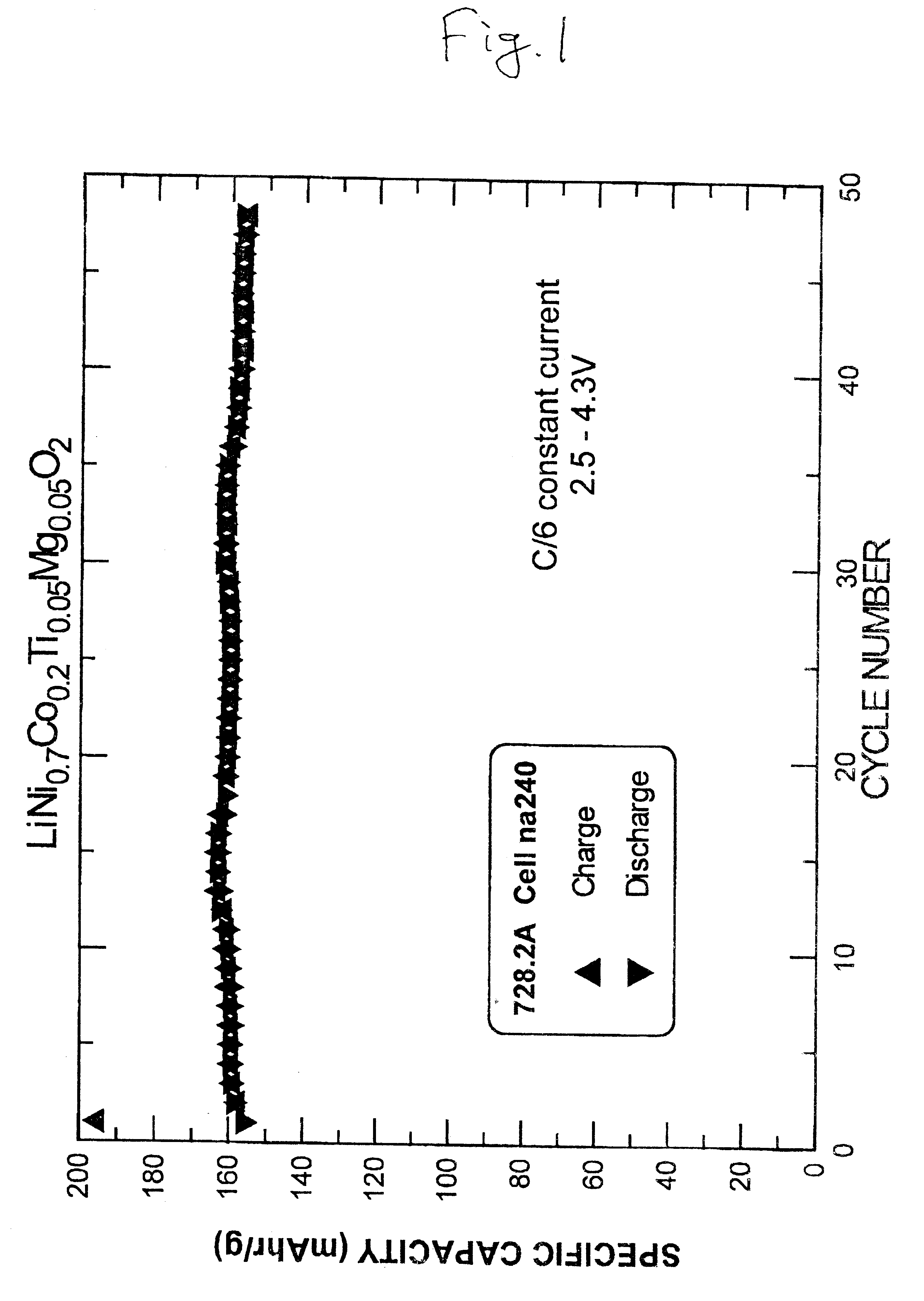Lithium metal oxide containing multiple dopants and method of preparing same
- Summary
- Abstract
- Description
- Claims
- Application Information
AI Technical Summary
Benefits of technology
Problems solved by technology
Method used
Image
Examples
example 1
Stoichiometric amounts of LiOH, NiO, Co.sub.3 O.sub.4, TiO.sub.2, and Mg(OH).sub.2 to give LiNi.sub.0.7 Co.sub.0.2 Ti.sub.0.05 Mg.sub.0.05 O.sub.2 are mixed and fired at a temperature of 550.degree. C. for 10 hours and then at 800.degree. C. for 10 hours in an atmosphere with the oxygen partial pressure close to 100 kPa. The cooling was controlled at 1.degree. C. / min down to 500.degree. C. followed by natural cooling to room temperature. A powder x-ray diffraction pattern of the intercalation compound shows a single phase material with a hexagonal (or rhombohedral) layered structure similar to that of .alpha.-NaFeO.sub.2. The same single phase material was also produced firing the mixture in an atmosphere with the oxygen partial pressure close to 20 kPa.
example 2
Electrochemical cells with lithium metal as the anode and cathodes with LiNi.sub.0.7 Co.sub.0.2 Ti.sub.0.05 Mg.sub.0.05 O.sub.2 (prepared according to Example 1) as the active material were made and tested. The electrolyte was 1M LiPF.sub.6 in a 50 / 50 volume percent mixture of ethylene carbonate and dimethyl carbonate solvents. Celgard 3501 separators and NRC 2325 coin cell hardware were used. The cathode consisted of 85% active material (by weight), 10% super S.TM. carbon black and 5% polyvinylidene fluoride (PVDF) as a binder polymer, coated on aluminum foil. The test results of one such cell is shown in FIG. 1. The cell was charged and discharged with a constant current of 0.3 mA between 2.5V and 4.3V. The active mass of cell was 9.9 mg, and therefore the current density per active weight was 30 mA / g.
As demonstrated in FIG. 1, the irreversible capacity for the cell is 35 mA.multidot.hr / g and thus the reversible capacity obtained at an upper cut-off voltage of 4.3V is 160 mA.multi...
example 3
LiNiO.sub.2, LiCoO.sub.2, LiNi.sub.0.8 Co.sub.0.2 O.sub.2, LiNi.sub.0.75 Ti.sub.0.125 Mg.sub.0.125 O.sub.2, and the intercalation compound LiNi.sub.0.7 Co.sub.0.2 Ti.sub.0.05 Mg.sub.0.05 O.sub.2 prepared in Example 1, were each used as the active cathode material for electrochemical cells prepared in the manner described in Example 2 using between 10 mg and 20 mg active material for each cell. The cells were first conditioning charged to 5.0 V and discharged to 3.0 V, and then float charged to 4.5 V with 0.2 mA current for 40 hours to ensure equilibrium conditions. The charged cells were then transferred to a glove box filled with argon and opened. Between 0.1 mg and 1.0 mg of the cathode material from the cells was removed and hermetically sealed into DSC cells. Each of cells contained 10-15% of the electrolyte described in Example 2. FIG. 2 illustrates the DSC results for these compounds with the area of interest magnified in the inset. The positive heat flow in FIG. 2 represent h...
PUM
 Login to View More
Login to View More Abstract
Description
Claims
Application Information
 Login to View More
Login to View More - R&D
- Intellectual Property
- Life Sciences
- Materials
- Tech Scout
- Unparalleled Data Quality
- Higher Quality Content
- 60% Fewer Hallucinations
Browse by: Latest US Patents, China's latest patents, Technical Efficacy Thesaurus, Application Domain, Technology Topic, Popular Technical Reports.
© 2025 PatSnap. All rights reserved.Legal|Privacy policy|Modern Slavery Act Transparency Statement|Sitemap|About US| Contact US: help@patsnap.com



